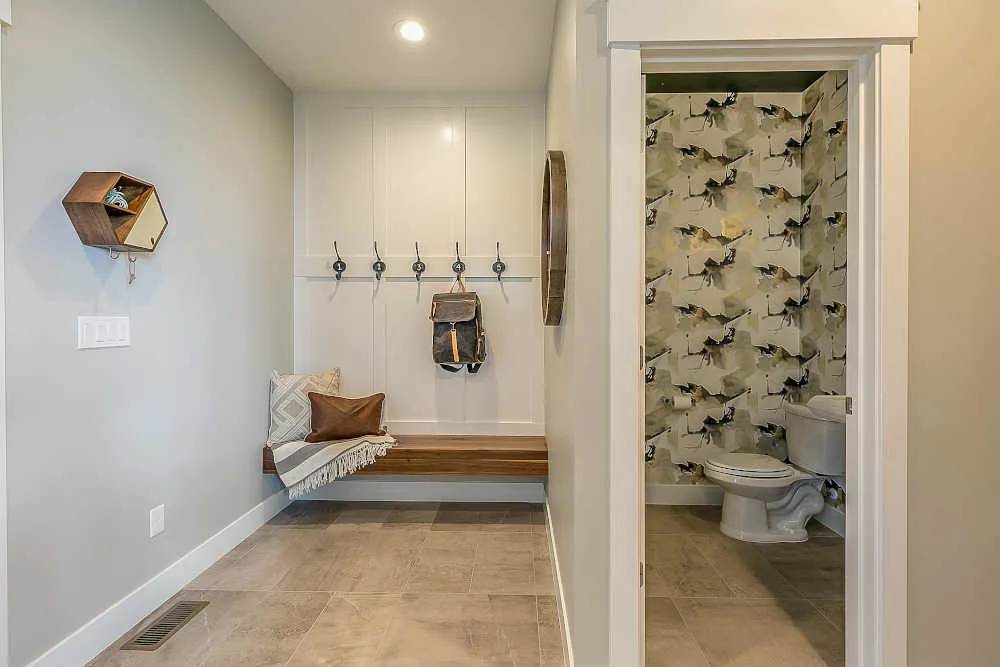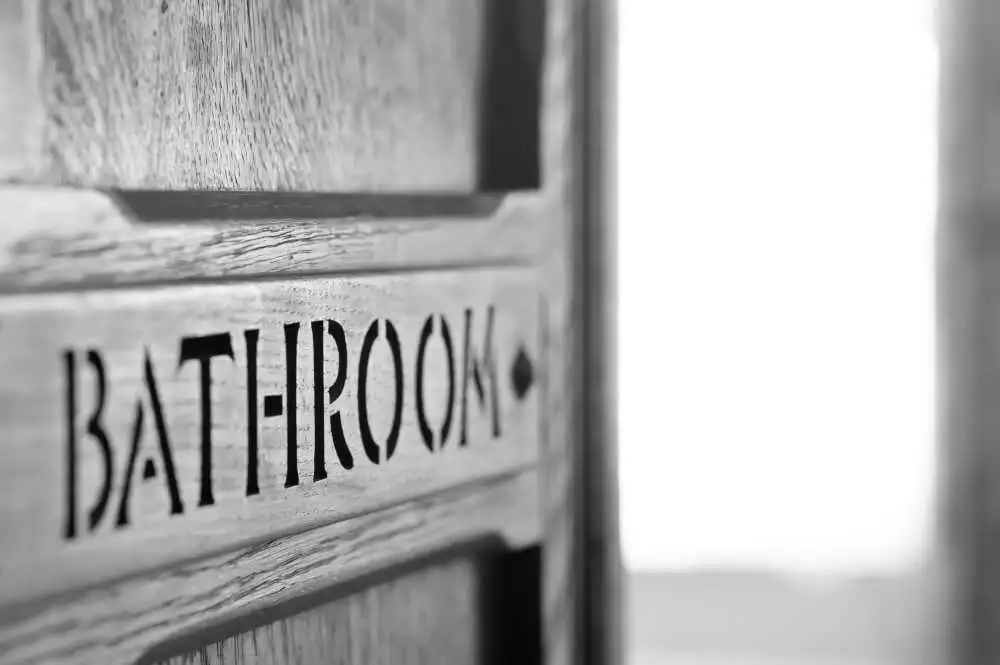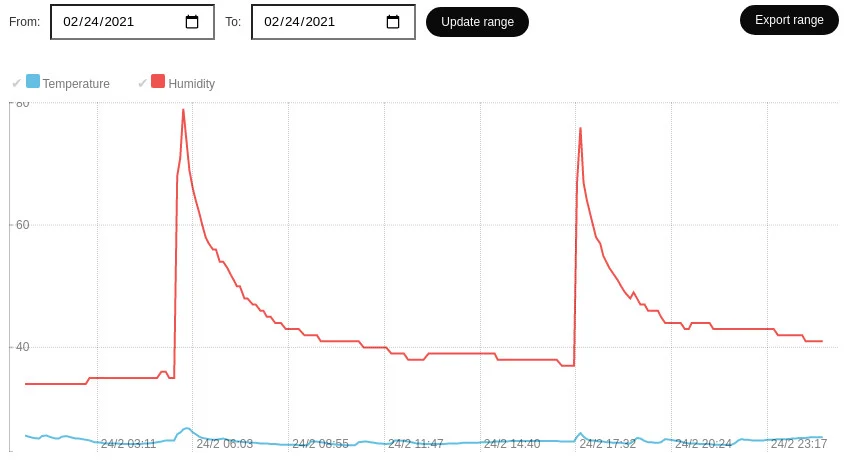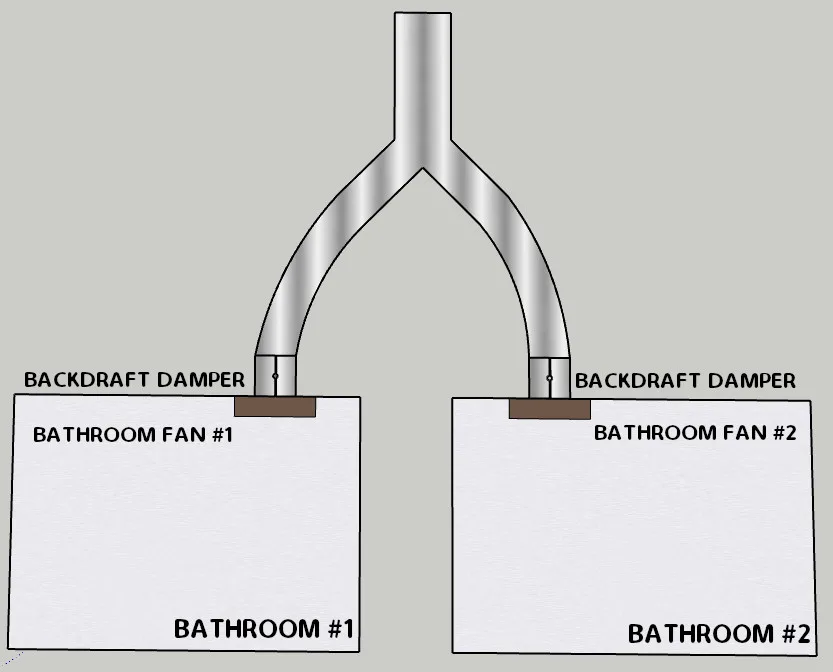Starting the day with a nice, warm shower is part of the routine for many people. However, you may not realize you’re damaging your home every time you don’t turn on the exhaust fan. Not turning on the exhaust fan or not having one encourages mold growth and structural damage even if you live in a dry climate.
Exhaust fans are necessary, but their installation and size depend on the space in which you install them. You may also have exhaust fans already, but they are venting to the wrong location or they are too small, which can damage your home. Proper exhaust fan installation and venting protect your investment and family.

Exhaust fans are necessary for bathrooms of all varieties due to the amount of moisture a running shower, bath, or sink adds to the room. There may also be exhaust fans in laundry rooms and utility rooms, especially interior ones, to remove moisture generated by appliances while they are in use.
Why are Exhaust Fans Necessary at All?
Exhaust fans, especially in bathrooms, promote your overall comfort. If you have ever showered in a bathroom without one, you know it only takes two minutes before it seems like you’re trying to breathe through pea soup. Without a working exhaust fan, the humidity a shower creates makes it hard to feel dry as well.

Related article: Bathroom Exhaust Fan Pros and Cons
Unfortunately, bathrooms are not the only place where moisture can enter the air as humidity and cause moisture buildup in your walls. Areas like laundry rooms or interior utility rooms are especially prone to moisture buildup that can weaken your drywall. This buildup can also cause your house studs to swell, which is not good for structural integrity.
The big issue with moisture buildup is the organisms it promotes. Both mold and fungus adore moisture, so moisture buildup in your walls or ceiling is paradise to them. Mold and fungus can cause various health problems like allergies or pulmonary fibrosis with long-term exposure.
Exhaust fans also help smells dissipate. Most often, moisture leads to a musty smell, especially in a small room. However, there are other smells that you may want to be removed from your bathroom. Exhaust fans work on all of them within minutes.
Additionally, the International Residential Code (IRC) also specifies the use of exhaust fans in bathrooms and other rooms with insufficient airflow. State and local building codes across the United States typically adopt IRC sections without much revision.
Does a Powder Room Need an Exhaust Fan?
Powder rooms do not technically require an exhaust fan if they have a functional window. This window must be at least 3 feet square, and it must open if used in place of an exhaust fan. IRC M1505.4.4 addresses the necessary exhaust rates for various rooms.

Powder rooms first appears in the 18th century as the room where wigs were re-powdered. The modern powder room consists of only a toilet and a sink. You may have one on the main level of your home for guests to use.
Related article: The Difference Between a Bathroom, Restroom, Washroom, Toilet, and Lavatory
Most modern homes incorporate an exhaust fan in the powder room because it effectively ensures a high enough ventilation rate in the room. You may find that the exhaust fan deals primarily with smells in a powder room rather than excessive moisture since sinks tend not to generate much humidity.
Since there is no excess moisture a ductless bathroom fan is an acceptable solution for a powder room. Ductless fans effectively remove smells by filtering the air through an activated carbon filter.
Exhaust Fans in the Laundry Room
Laundry rooms may not seem like they need exhaust fans. However, most do not meet the requirements for airflow in a room people use without them. Additionally, you may want one since washers generate humidity while they are in use.
Your laundry room may not have an exhaust fan, but this is normally because the calculated airflow rate is sufficient for the area.
For example, laundry rooms tucked behind a louvered door in a hallway take advantage of the larger area’s airflow.
Remember, a dryer is a different situation. Per IRC M1502, clothes dryers must have separate ventilation systems from all other systems in the house.
They must also vent directly outside, and homeowners should have the dryer vent cleaned at least once per year.
Does a Utility Room Need an Exhaust Fan?
A utility room houses large appliances, such as water heaters, HVAC systems, washers, and dryers. Your home’s utility room may be your laundry room, or it may be a separate space depending on the type of water heater and your builder.

Each type of water heater has slightly different requirements for ventilation. Those that use combustion, such as gas or propane, require a ventilation system per IRC G2407. Meanwhile, solar systems do not require exhaust fans.
Often, your water heater, furnace, or other utility appliances may share an exhaust system. Provided the system size is appropriate, this should not present any issues. If you replace one of the appliances, ask the installing technician if the exhaust system can still handle it.
Is an Exhaust Fan Required in a Half Bath?

A half bath is typically the same as a powder room with only a toilet and sink. However, any combination of two of the four main bathroom appliances counts as a half bath. A bathtub and a toilet would count as a half bath since it does not contain a sink and shower.
If there is either a shower or a bathtub in the half bath, it will add moisture when in use and require an exhaust fan. IRC M1505.4.4 contains the minimum exhaust rate, though it may be wise to exceed the minimum to prevent moisture buildup. Remember, exhaust from a bathroom must vent directly outside.
Do Basement Bathrooms Need Exhaust Fans?
Basement bathrooms require an exhaust fan unless your home layout has an operable window with enough airflow to vent the space. This requirement applies even if the basement bathroom does not have bathing facilities.

In most basements, this means an exhaust fan that must vent directly outside per IRC M1501.0 and M1505.2 and cannot vent into an unfinished area of the home.
But neglecting to install an exhaust fan can make the effort useless since the moisture damage that will be caused by an unventilated bathroom will be expensive to remove.
If you are finishing a basement, ensure that your contractor understands this requirement to avoid penalties at inspection.
Does a Bathroom Need an Extractor Fan?

Bathroom fans are required by code only when natural ventilation is insufficient. But bathroom fans are still necessary when there are windows. Windows can’t always be opened, so they are unreliable ventilation sources. Ventilation is necessary to prevent cosmetic and structural damage and mold growth.

Code Dictates When Bathroom Fans Are Required
You might question whether “required” is the same as “necessary”. I do. I think that what is required can be considered to be what has to be done, and what is necessary can be considered to be what should be done.
There are situations in which a bathroom fan is not required, but it is still necessary.
So, let’s start with when bathroom fans are required. This information can be found in Section R303.3 of the International Residential Code (IRC), which is the document on which most American states base their local codes.
The IRC says that bathrooms need at least 1.5 sq. feet. (0.15 m2) of openable window area in order to meet the minimum ventilation requirements. This is natural ventilation.
If your bathroom does not meet this minimum, then you are required to install a local exhaust system that can exhaust air at a rate of 50 CFM (intermittent) or 20 CFM (continuous), where CFM stands for cubic feet of air per minute. These rates can be found in IRC Section M1505.4.4.
Great, so your bathroom meets the minimum natural ventilation requirements, so you’re good without a fan, right?
Well, you’d certainly pass an inspection. But here we come to the nuance of requirement versus necessity.
Requirement Versus Necessity
The primary purpose of bathroom ventilation is to remove excess heat and moisture before it can damage your house; it’s not just a hoop the government is trying to make you jump through.
To get the benefits of your natural ventilation, you have to keep your bathroom windows open.
So, what happens in winter, when it’s freezing cold outside? Or when there’s a driving rain pelting against the side of the house? Or when your neighbor’s window is right next to yours? Or when your bathroom is on the ground floor and there are opportunistic criminals around? Or when you have to keep your cats inside the house?
There are so many reasons why you would keep your bathroom window closed, and when you do, the moisture does exactly what you don’t want it to do to your home.
From my own experience, I can report that it can lead to moisture problems in the attic, and if not spotted in time, it can be a very expensive problem.
In my opinion, this makes bathroom fans necessary in every situation.
I believe most people who are hesitant to install a bathroom fan have never had a bathroom without an exhaust fan. I have had the “pleasure,” and I can tell you the constant fight with moisture is not worth it!
Let’s take a closer look at how bathroom fans provide ventilation and how they protect your home, even if you have nice big windows in the bathroom.
Bathroom Fans Exhaust Moisture Out of the House
Bathroom exhaust fans are electric devices that draw air out of the bathroom, move it through a ductwork system, and exhaust the moist, hot air to the outside of the house, where its damaging influence is negated.
If you are interested in understanding how the actual fan works, you can read about it in How Does a Bathroom Exhaust Fan Work?
The removed air is then replaced with dryer, fresher air that is pulled into the bathroom from other areas of the house (which, in turn, have been supplied with air from the HVAC system or from outdoors) or through cracks or openings in the walls, windows, and doors separating the bathroom from the outdoors.
It is very important that this moisture is removed from the house and not just the bathroom. If you vented the bathroom fan into, say, the attic, then you would just suffer a smorgasbord of issues in your attic.
Fan Capacity and Running Time
Of course, the bathroom fan must have sufficient CFM to be able to exhaust enough air to make it efficient. An adequately powered bathroom fan will exhaust the moisture before it has time to condense on most of the surfaces, including the mirror (no more foggy mirrors!).
The exhaust fan needs to run at least 30 minutes after the shower in order for all the moist air to be replaced and for all the air in the ducts to be exhausted.
Here you can see it will take almost 1 hour before the moisture level drops to a normal level. This is with the exhaust fan running. It would take many hours without it.

Bathroom Fan Options
There are various types of bathroom fans to choose from. They can be divided into installation categories: wall-insert, ceiling-insert, and inline.
Ceiling-insert fans are the most popular option, largely because putting a fan on the ceiling works with the natural movement of steam, making it the ideal placement.
Wall-insert fans are a good option if you don’t want to install long ductwork through the ceiling and walls.
It does require the bathroom to have an external wall into which the fan can be inserted, but by installing a fan that is designed specifically for vertical mounting, the installation will be much easier since most of them will include a collar that will go into the wall construction.
If there happens to be another bathroom nearby, they could share a duct and possibly make the installation much easier. In such cases, you have the option of installing a fan in each bathroom or an inline fan in the combined duct.
Keep in mind that the duct size must be sufficient in order for both of them to work at the same time.

You also get humidity sensing bathroom fans (amazon link) that will turn on when humidity exceeds a certain level and turn off again when it drops below this. They are a little pricier, but they are worth it because they don’t rely on people to turn them on and leave them on long enough.
Another option to eliminate human error-related moisture issues is a fan with a timer switch.
I highly recommend installing a bathroom exhaust fan in a bathroom where there is a shower or a bath. I have created a quick guide on how to choose the perfect bathroom fan for your needs.
Ductless Bathroom Fans
A ductless bathroom fan is not suitable for use in a bathroom with a shower or a bath if you want your bathroom to be ventilated up to code. They are meant for closets, pantries, and quarter baths (bathroom with only a toilet).
Ductless bathroom fans do not remove any moisture from the air. They filter the air through an activated carbon filter to improve air quality and remove some of the odors.
Don’t Forget To Install A Backdraft Damper
A backdraft damper is a simple flap that is operated either by gravity or a spring. This will stop the vent from drafting and dripping and, as a bonus, will keep insects out of your house and ventilation system.
Try to avoid cheap gravity-operated dampers. I can guarantee that it will drive you mad when it starts to flap in the wind.
Instead, invest in a quality spring-operated rubber-sealed damper. I recommend AC infinity dampers (amazon link). They use quality rubber seals to prevent noise and any air leaks. They have dampers from 4 to 8 inches to fit most applications.
Ways in Which Moisture Is Harmful/Damaging
Hot showers and baths create a lot of moist air in a relatively small space. If the moisture is not removed, it can lead to serious problems that can cost thousands to fix later.
Moisture can cause cosmetic damage like stained or peeling paint and wallpaper. While it may be cheaper to repaint or repaper your bathroom every couple of years than it is to install and maintain a bathroom fan, moisture can also cause more serious problems.
Excessive exposure to water can result in rotting floor, wall, and ceiling beams, and rusted metal supports. Compare the price of a bathroom fan and its ductwork to rebuilding a section of your home, and you will quickly agree about the necessity of the fan.
And I haven’t even mentioned mold and mildew! These thrive in environments that are exposed to excessive moisture on a regular basis. An unventilated or poorly ventilated bathroom is just such a place.
Daily addition of moisture by showering will make it a perfect environment for mold and mildew to thrive.
Having mold in your house is a really bad situation. Mold and mildew are ugly and difficult to remove (you may have to pay a professional to come in several times just to get rid of it properly).
But beyond this, and more concerning, are the adverse health effects associated with mold and the fact that it can cause structural damage to the surfaces on which it grows. Often the mold starts in cold corners of the bathroom since that’s where the moisture will condensate first, and dry out last.
If the surfaces are hidden and you only notice the mold problem when it’s prolific or affecting the health of your family, then you will have a difficult and expensive task ahead of you.
Remember I said that I experienced moisture issues in the attic because I didn’t have a bathroom fan? Well, I only knew that I had moisture problems in my attic when I noticed mildew coming out of the soffit.
Luckily, I caught it in time and it had not spread too far so the cleanup was not as bad as it could have been. Others have not been as lucky. By staying hidden for months or even years, the problem can get very serious before it is uncovered.
Related article: Can a Dehumidifier Be Used Instead Of a Bathroom Fan?
Secondary Benefits of Bathroom Fans
Bathroom Fans Remove Smells
Bathroom fans are very efficient at removing various odors from the room. A properly sized bathroom fan will exchange all of the air in the bathroom 8 times an hour, so every 7.5 minutes or so, any odor that was in the bathroom is removed completely.
While the removal of odors is a matter of convenience when it comes to human-based odors, it’s a different story when using chemicals to clean the bathroom. A bathroom is usually a very confined space and using toxic chemicals in there can make the person who is cleaning feel rather ill.
Opening a window during the winter months will be impractical, so you are left with a bathroom filled with toxic chemicals.
If you really don’t want to install a bathroom fan (or you cannot), then at least get a quality respirator to protect yourself from toxic fumes when cleaning.
I highly recommend the 3m 6503QL (amazon link) paired with a 60923 filter (amazon link). This filter offers the best combination of protection from organic compounds and particles. It’s perfect for all types of home improvement projects.
Bathroom Fans Can Be Used To Exhaust Paint Fumes

While the main purpose of bathroom fans is to exhaust moisture and foul odors, they can be used for alternative purposes.
Most people will at some point paint the rooms in their homes. A bathroom fan could be used to ventilate the surrounding rooms while they are being painted. While this is something that will only use once every 5-10 years, it is very handy when it comes time to give a new coat of paint to your living space.
You can read more in my list of Bathroom Exhaust Fans Pros and Cons.
What if It Is Impossible to Install a Bathroom Exhaust Fan
While I don’t believe there is anything impossible, it might be very difficult to install a ducted exhaust fan in your bathroom.
A bathroom that is in the middle of the house, with no attic access and no crawl space does make running ducting to the bathroom very difficult.
There are some alternative methods that will make the situation better. But for the most part, they are all band-aid solutions and not long-term fixes.
A powerful dehumidifier (amazon link) for humidity control and a ductless fan (amazon link) to deal with odors will be the best option when a real bathroom fan is out of the question for some reason.
You can find more about these supportiv


